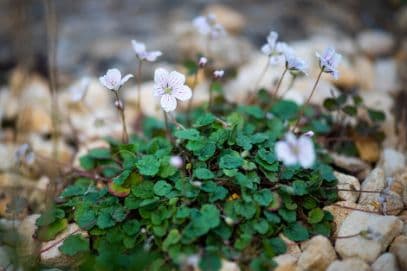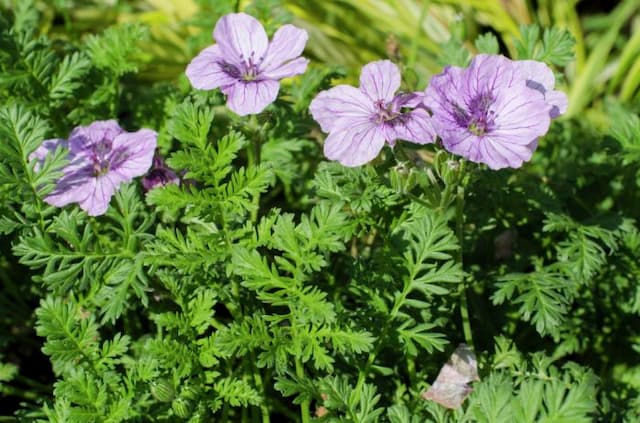Geranium Pelargonium 'Splendour' (R)

ABOUT
Pelargonium 'Splendour' is a striking and vibrant plant known for its lush, decorative foliage and showy flowers. This plant typically exhibits rounded leaves that are soft and velvety to the touch with a unique zonal pattern, which often manifests as darker green or reddish-brown hues in the center, surrounded by a lighter green. The leaves may also have a slightly ruffled or scalloped edge, adding texture to the plant's profile. The most captivating aspect of Pelargonium 'Splendour' is its flowers, which burst forth in clusters known as inflorescences. The blossoms themselves are comprised of five petals, frequently boasting bold and vivid colors, such as bright pinks, purples, reds, or even white. These petals might be adorned with contrasting colored streaks or speckles that enhance their visual impact. The flowers are typically showcased above the foliage on slender stalks that allow them to catch the attention of both pollinators and plant enthusiasts alike. Furthermore, this variety of Pelargonium is known for its pleasant fragrance, which can add a layer of sensory appeal to gardens or indoor plant collections. The scented leaves may release their aroma when brushed against or when the ambient air is warm, contributing to the overall allure of the plant.
About this plant
 Names
NamesFamily
Geraniaceae
Synonyms
Fancy Leaf Geranium, Zonal Geranium, Horseshoe Geranium, Fish Geranium
Common names
Pelargonium 'Splendour' (R).
 Toxicity
ToxicityTo humans
Geraniums, such as the Pelargonium 'Splendour', are generally considered non-toxic to humans. However, ingestion of large quantities of plant material could potentially cause mild gastrointestinal upset such as vomiting or diarrhea in some individuals. It is always advisable to avoid eating ornamental plants as a general safety precaution.
To pets
Geraniums, including the Pelargonium 'Splendour', may be toxic to pets, especially cats and dogs. The most common symptoms of geranium poisoning in pets are vomiting, lethargy, anorexia, depression, and skin irritation. If a pet ingests part of a geranium plant, it is important to contact a veterinarian as soon as possible for appropriate care and treatment.
 Characteristics
CharacteristicsLife cycle
Perennials
Foliage type
Evergreen
Color of leaves
Green
Flower color
Mixed
Height
1-2 feet (30-60 cm)
Spread
1-2 feet (30-60 cm)
Plant type
Herb
Hardiness zones
9
Native area
South Africa
Benefits
 General Benefits
General Benefits- Easy to Grow: Pelargonium 'Splendour' is known for being a hardy and easy-to-grow plant, suitable for gardeners of all skill levels.
- Attractive Blooms: This variety offers showy flowers that can bring vibrant color and visual interest to a garden or container.
- Drought Tolerance: It has a good tolerance for dry conditions, making it a suitable plant for regions with water restrictions or for gardeners who prefer low-maintenance plants.
- Pest Resistance: Pelargonium 'Splendour' has a natural resistance to many common garden pests, reducing the need for chemical treatments.
- Long Flowering Period: It boasts a long blooming season, providing flowers from spring to autumn in the right conditions.
- Versatility: It can be used in a variety of garden settings, including borders, containers, and as a bedding plant.
- Fragrance: Some pelargoniums are known for their pleasant scent, which can add another layer of enjoyment to the garden or home.
 Medical Properties
Medical PropertiesThis plant is not used for medical purposes.
 Air-purifying Qualities
Air-purifying QualitiesThis plant is not specifically known for air purifying qualities.
 Other Uses
Other Uses- As a natural insect repellent: Planting Pelargonium 'Splendour' near outdoor living spaces can help deter mosquitoes and other insects due to its fragrant leaves.
- In perfumery: The essential oil extracted from the scented leaves of Pelargonium 'Splendour' is sometimes used in the creation of perfumes and fragrances.
- As a flavoring agent: The leaves of Pelargonium 'Splendour' may be used to flavor jellies, teas, and baked goods with its unique and subtle scent.
- In art and photography: The vibrant flowers of Pelargonium 'Splendour' are often used as subjects in botanical art and photography due to their striking appearance.
- As a natural fabric dye: The intense colors of Pelargonium 'Splendour' can be used to dye fabrics and yarns naturally.
- In potpourri: Dried flowers and leaves of Pelargonium 'Splendour' can be included in potpourri mixes for their fragrance and attractive appearance.
- For educational purposes: Pelargonium 'Splendour' can be used in schools and educational programs to teach botany and plant biology.
- As a companion plant: The Pelargonium 'Splendour' can be planted alongside vegetables and fruit bushes to enhance pollination and protect against certain pests.
- For bonsai: With proper pruning and care, Pelargonium 'Splendour' can be cultivated as a bonsai plant, offering an aesthetic and horticultural challenge to enthusiasts.
- In special events: The bright blooms of Pelargonium 'Splendour' can be used in floral arrangements for weddings and special events to add color and beauty.
Interesting Facts
 Feng Shui
Feng ShuiThe Geranium is not used in Feng Shui practice.
 Zodiac Sign Compitability
Zodiac Sign CompitabilityThe Geranium is not used in astrology practice.
 Plant Symbolism
Plant Symbolism- Comfort and Healing: Geranium 'Splendour', commonly known as Geranium, is often associated with comfort due to its pleasant scent and the soothing effect it has on the mind.
- Good Health: Geraniums symbolize good health as they are thought to purify the air, promoting a clean and healthy environment.
- Friendship: Giving a geranium plant is a gesture of friendship; it represents closeness and a shared bond between people.
- Positive Emotions: The bright and colorful flowers of the geranium are believed to evoke positive emotions, symbolizing happiness and joy.
- Fertility: In some cultures, geraniums symbolize fertility and creation, representing the perpetuation of life.
 Water
WaterGeraniums, including the Pelargonium 'Splendour', require even moisture and should be watered thoroughly when the top inch of soil feels dry to the touch. Typically, this might mean watering once a week, but frequency can increase during hot, dry periods to perhaps twice a week. It's best to water these plants in the morning to allow foliage to dry before nightfall. When watering, aim for about one to two gallons per square yard of soil, depending on the size of the plant and environmental conditions, ensuring that the water penetrates deeply to encourage root growth but does not leave the soil waterlogged.
 Light
LightGeraniums thrive in a spot with plenty of bright, indirect sunlight. They enjoy about six to eight hours of light per day, so a south or west-facing window is ideal for indoor plants, while in the garden, a location that gets full sun to part shade will support healthy growth. Direct midday sun can sometimes be too intense and might require some light shading, especially in hotter climates.
 Temperature
TemperatureGeraniums prefer moderate temperatures and perform best when daytime temperatures are between 65°F and 75°F and nighttime temperatures are above 50°F. While they can survive brief periods of colder weather, geraniums are not frost-tolerant and should be protected if temperatures are expected to drop below 30°F. The ideal growing temperature range for geraniums ensures healthy growth and blooming.
 Pruning
PruningPruning geraniums helps to promote bushy growth and prevent legginess. It's best to prune them in early spring before new growth begins or just after the last frost. Remove dead or yellowing leaves and spent flowers regularly to encourage more blooms. Pruning can be done every few months to maintain shape and encourage new growth, focusing on cutting just above a leaf node or branching point.
 Cleaning
CleaningAs needed
 Soil
SoilGeraniums thrive in well-draining soil with a pH between 6.0 and 7.0. A mix of two parts peat moss, one part perlite, and one part compost is ideal, ensuring nutrients and good drainage.
 Repotting
RepottingGeraniums should be repotted once a year, typically in spring, to rejuvenate soil and allow for growth.
 Humidity & Misting
Humidity & MistingGeraniums prefer moderate humidity levels, around 40-60%, and good air circulation to thrive and avoid diseases.
 Suitable locations
Suitable locationsIndoor
Place in bright, indirect light and keep soil moderately dry.
Outdoor
Plant in well-drained soil, full sun to part shade.
Hardiness zone
10-11 USDA.
 Life cycle
Life cycleGeranium 'Splendour' (Pelargonium 'Splendour') starts its life as a seed, which, when sown in well-draining soil and provided with warmth, will germinate. The seedling stage follows germination, where the plant begins to develop its first true leaves. As it enters the vegetative stage, the geranium grows larger, producing more leaves and branches, and it will continue to expand in size if given ample light and nutrients. The next stage is the flowering phase, where the plant produces vibrant flowers that can attract pollinators and are often used for ornamental purposes. After pollination, the plant may produce seeds, completing its reproductive cycle. Finally, as an annual or perennial depending on the climate, the geranium may either die after one season or go dormant and regrow the following spring if conditions allow.
 Propogation
PropogationPropogation time
Spring-Early Summer
The Pelargonium 'Splendour', commonly known as Geranium 'Splendour', is best propagated through stem cuttings. This technique is most effective if done in late summer, but can also be performed at other times of year with reasonable success. To propagate Geranium 'Splendour' by cuttings, start by selecting healthy, non-flowering stems around 4 to 6 inches long. Trim the cuttings just below a node, the point where leaves emerge, and remove any leaves from the bottom half of the cutting. Dip the cut end in rooting hormone powder to encourage root development. Plant the cuttings in a mix of peat and perlite or a well-draining potting mix, ensuring that at least two nodes are buried. Keep the soil moist but not waterlogged and in a warm, indirect light area until roots establish and new growth appears, indicating successful propagation.




![Cranesbill [Blue Sunrise]](/_next/image?url=https%3A%2F%2Fplants-admin.emdemapps.com%2Fimages%2Fplants%2F%2Fimages%2F604b638d45948.png&w=640&q=75)




